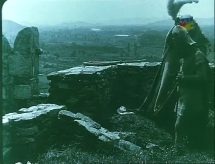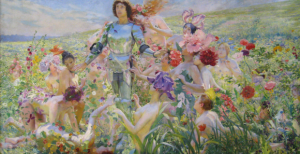Wagner’s Parsifal

(The Music of Redemption) by Roger Scruton (2020)
Some Brief Words From the Wise on Holy Communion
“…it belongs to that class of myths which have been dramatised in ritual, or, to put it otherwise, which have been performed as magical ceremonies for the sake of producing those natural effects which they describe in figurative language. A myth is never so graphic and precise in its details as when it is, so to speak, the book of the words which are spoken and acted by the performers of the sacred rite.”*
“It would indeed be impossible to devise a mystery capable of keeping men more effectually within the bounds of virtue.“‘**
“Combined with the recollection of the Passover and of the first covenant, [The Eucharist] is lost in the remoteness of time; it reproduces the earliest ideas of man, in his religious and political character, and denotes the original equality of the human race. Finally, it comprises the mystical history of the family of Adam, their fall, their restoration, and their reunion with God.”^
Working Out the Weirdness of Wagner
In these times of pestilence, it has been an additional blow for The Varnished Culture to have suffered cancellations of the production of Lohengrin in Melbourne and Opera Australia’s production of The Ring in Brisbane. First World problems, we know, but it brings additional sadness. Still, there are compensations, including Roger Scruton’s last book. While Roger’s writing style makes the reader feel s/he is walking through 2 solid feet of brimstone and treacle, it is a pretty wonderful, dense book, with very many good things to find about Wagner’s last, and possibly his best, and indubitably his weirdest, opera: Parsifal, first performed at Bayreuth on July 26, 1882 under the auspices of the Maestro’s catchy tagline – ”ein Bühnenweihfestspiel.”
Roger Scruton has thought long and hard about this work and pondered the nature of religious/spiritual belief, finding therein a kind of soulless solace. Wagner was something of a one-man cult who borrowed (with sublime irreverence) from myth to create, in his music-dramas, a counter-myth: not a God, but a ‘Godliness.’ Where Dostoevsky strove to ‘find the man in man,’ Wagner – certainly not a Christian – looked for God in man. It was his heroic quest, and reflective of his respect for religion and myth as spiritually true. He read deeply in the grail oeuvre: Troyes, Boron, Eschenbach, Malory, and rejected the mere mercantile world in which he so often became personally embroiled, desiring instead, or to add, a heroic consecration. Wagner is a sort of Secular Church.
Certainly, he is far from the Christian archetype. Art trumped God, or, rather, was God. Scruton cites Wagner’s 1880 essay ‘Religion and Art’: “it is reserved to art to salvage the kernel of religion, inasmuch as the mythical images which religion would wish to be believed as true are apprehended in art for their symbolic value, and through ideal representation of those symbols art reveals the concealed deep truth within them.” The central paradox of Parsifal, that clings to the mind like chewing-gum to the sole of a shoe, is that Wagner, rather prone to self-pity, saw himself as the Great Redeemer of German and indeed World Art. The termination of the show brings forth the phrase ‘Redemption to the Redeemer.’ A plausible case can be made for this, though Scruton cites Nietzsche on the obsequies when the Maestro died: “Many (strangely enough) made the small correction [to the wreath]:”Redemption from the Redeemer.” One breathed a sigh of relief.” And many no doubt later inhaled through the mouth at the inevitable stench of Hitler declaring he had built his own deification project on the footings of Parsifal.
Synopsis
Scruton repeats himself a fair bit in this book (it probably needed some final polishing at the time of the author’s death early this year) and whilst he gives a potted synopsis of the opera’s plot (invariably a bad idea) in his first chapter, he gives an even longer exegesis in the next. One wanted to close the book and go watch the opera. Still, along the way he interprets the action with such learning and erudition that it becomes an invaluable annotation both to the score and the libretto. For the uninitiated, we’ll sketch the story here in its Trinity of Acts:
ACT 1
King Titurel was given the Holy Grail to keep safe at Montsalvat, guarded by knights headed by the King’s son, Amfortas. One knight (Klingsor) went off the reservation and was outcast, even after emasculating himself to simulate chastity, or recover it. In a fury, he created a magic castle of earthly delights, with which he tempted and corrupted the knights, including Amfortas, who was seduced by Kundry (Klingsor’s love slave) and ambushed by Klingsor, who wounds him with the Spear that rent Christ’s side on the Cross.
Now Amfortas is house-bound with a wound that won’t heal (his musical motif “wobbles on its augmented triad as if every note were a jolt of pain“), and Montsalvat has fallen into despond. Kundy drops in with some balm – she’s torn between loose and clean living, but the senior knight, Gurnemanz, says only a holy fool can cure Amfortas and the rest. Enter Parsifal, in trouble for straying in the sacred grove and shooting a swan into the bargain (Lohengrin wouldn’t have done that). On questioning, he appears to be as incoherent, indifferent and grumpy as Kaspar Hauser. He’s taken to the Grail Hall and given marching orders.
ACT 2
Parsifal wends into the Waste Land of heathen Spain, cuts his way along the ramparts of Klingsor’s Castle and into the garden, where he resists the flower maidens. Meanwhile, evil puppeteer Klingsor has directed Kundry to set him up as they did Amfortas. Kundry (the serpent in the garden, linked to Tannhäuser as Parsifal is to Lohengrin) is wracked with guilt (having mocked the man on the cross, and sundry other misdemeanours) and filled with passionate yearning and intensity, but Parsifal, in a remarkable musical sequence, rejects her, deflects Klingsor’s spear, and with a papal gesture turns Klingsor’s edifice to dust. Thus he paves the way for Kundry’s eventual redemption, as she has paved that course for him. Meanwhile, we imagine Klingsor as Herman Hesse imagined someone like him:
“Wandering long, I have done and suffered much,
Now at evening I sit, I drink, and wait
Fearfully till the flashing scythe
Parts my head from my leaping heart.”^*
ACT 3
Good Friday. Parsifal, at the end of a long wander, meanders in to Montsalvat; this time he has the spear. He absolves Kundry, even though she reminded him his neglect killed his mother. On a roll, he attends the Eucharist and heals Amfortas by laying the spear on his wound. Kundry dies cleansed, expiated in holy service to the Grail and its temple, a true reformed heroine. Time (chronos) becomes space (kairos); even Titurel briefly resurrects. The Grail is illumined. Parsifal, the holy idiot, has been transformed into a wise man through compassion (durch Mitlied wissend).
Themes
For The Varnished Culture, Parsifal is Wagner’s most wondrous and enigmatic work, containing his most subtle and beautiful music. If you are not in the right mood, however, it can strike as trite, pretentious, overblown, and almost nauseating; in the wrong frame of mood, you wish to eliminate metaphysics (Scruton sums up some opinions of the work: “provocative, holy, religiose and blasphemous“). In actual fact, Parsifal, more than any other of Wagner’s works, needs to be treated with reverence: no Regietheater treatment can work in this space, as Scruton points out.
But what does it all mean? That which cannot be articulated, in sum, but Scruton (who has been described as “the knight errant of western civilization“) can clothe the central mystery with fine words and thoughts, woven into a complex portrait of musical structure, the collision between myth and humanistic philosophy, and the mystery of redemption. From the initial three chapters:
“[Wagner] understood, as few before or after him have understood, that the sacred, the sacrificial and the sacramental are aspects of a single world-changing endeavour: the endeavour for which ‘redemption’ was Wagner’s name. He had the uncanny ability to explore beneath our sophisticated rituals, in order to discover their roots in the pre-history of humankind. And in doing so he revealed what our rituals mean. Wagner regarded the concept of the sacred as indispensable to human relations. But he also believed that it is we who render things sacred, and that no God has a part in it.” (at pp. 37-38).
“The music (Act II) weaves together the sacred and the desecrated, the pure and the polluted, the giving and the refusing. We hear the holy as it changes to the unholy and yet remains the same. Such enharmonic changes of the passions, are delivered by the enharmonic language of the score, and the uncanny sense of unity between all that we hope for and all that we fear is in the end what Parsifal is about. ‘You know where to find me,’ says Parsifal – namely, in you.” (at pp. 52-53).
“…the Percival legend is given an allegorical form, telling just the same story as the books of alchemy, and as the tales of Oedipus, Antigone and the rest – the story of the self in its search for the anima that completes it, healing the wounds of separation from the mother, so as to become the ‘divine son of the mother’ as in a pietà.” (at p. 70).
Roger Scruton’s fourth chapter, ‘Sin, Love and Redemption,’ parses the real meaning of Wagner’s explicit and implicit references to compassion, sympathy, empathy, agape, as forms of endogenous knowledge. Wagner might appropriate godliness to humans, “But human creations include some very real and lasting things, such as St Paul’s Cathedral.” “The gods come about because we idealise our passions, and we do that not by sentimentalising them but, on the contrary, by sacrificing ourselves to the vision on which they depend. And it is by accepting the need for sacrifice that we begin to live under divine jurisdiction, surrounded by sacred things, and finding meaning through love. Seeing things that way, we recognise that we are not condemned to mortality but consecrated to it…the redemptive quality of sacrifice does not consist in conveying us to another world where we live in bliss for ever, but in transforming our vision of this world.”
It cannot be right that “In the innermost core of Wagner’s idea of redemption dwells nothingness” (Theodor Adorno, of whom we have spoken in sorrow before, and whom Scruton deals with justly and dismissively). Rather, the substance of Parsifal, whilst elusive, is reflected in Scruton’s peroration at the conclusion of his last chapter of substantive thematic discussion (later chapters concentrate on musicology, including enharmonics, consonance and tonal grammar, and the leitmotifs, beyond the scope of this review and beyond the wit of this reviewer):
“We have been called not to explore the world, but to rescue it. In doing so we emerge from our trials and conflicts in full possession of our social nature. Like the Redeemer, we make a gift of our suffering, through an act of consecration that brings peace to us all. Whether or not there is a God, there is this hallowed path towards a kind of salvation, the path that Wagner described as ‘godliness’. That is the path taken by Parsifal, and it is a path that is open to us all.” (at pp. 124-125).
NOTES
[* J.G Frazer, The Golden Bough (1890), chapter 612.] [** Voltaire, Questions sur l’Encyclopedie (1770-1774), Book IV.] [^ Chateaubriand, The Genius of Christianity (1802), Chapter VII.] [^* Hesse, Klingsor’s Last Summer (1920).]Leave a comment...
While your email address is required to post a comment, it will NOT be published.






0 Comments